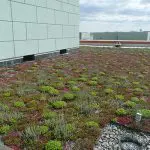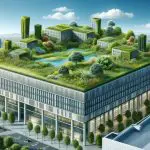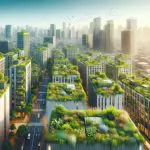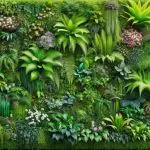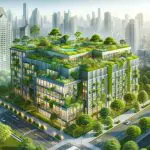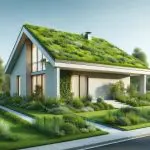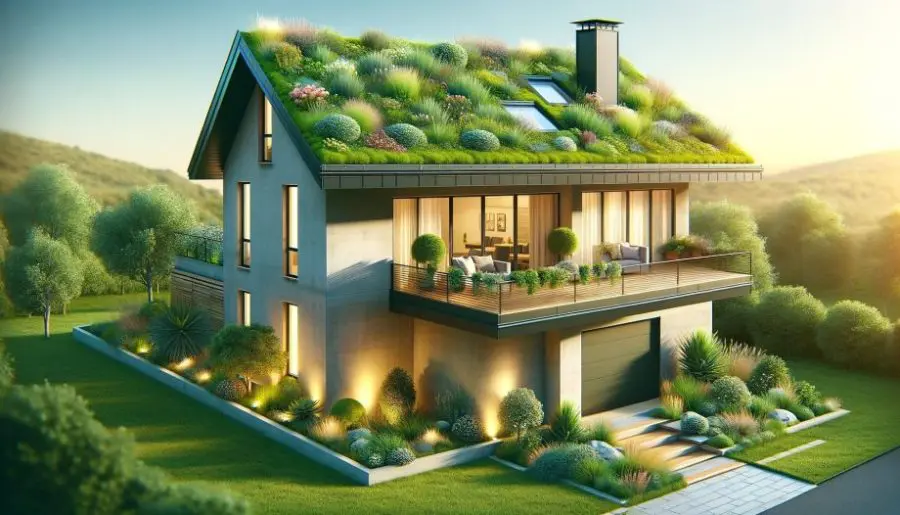
Explore the world of different types of green roofs, from extensive to intensive, and discover their unique benefits in urban environments.
Types of Green Roofs Key Takeaways:
- Different types of green roofs include:
- Extensive green roofs, which are low-maintenance with shallow soil for small plants
- Semi-intensive green roofs, offering a wider variety of vegetation with moderate care
- Intensive green roofs, akin to rooftop gardens with diverse plants and high maintenance needs.
Welcome to the verdant world of different types of green roofs! These eco-friendly marvels are transforming urban landscapes, offering a blend of beauty, sustainability, and practicality.
Join us as we delve into the fascinating varieties of green roofs, each with its own charm and set of advantages for our cities.
1. Different Types of Green Roofs
Green Roofs in Urban Architecture
Green roofs are becoming a staple in urban architecture, changing the way we view the traditional rooftop.
What are green roofs, you might wonder?
Simply put, they are roofs covered with vegetation, bringing a slice of nature into the concrete jungle.
This idea isn’t just for show; green roofs are part of a growing movement towards sustainable living.
Popularity and Environmental Benefits
Their popularity in cities is skyrocketing, and for good reason.
Green roofs provide a breath of fresh air, both literally and figuratively.
They’re like mini-parks in the sky, offering a patch of green in a sea of grey.
It’s not just about aesthetics, though. These living roofs pack a punch in environmental benefits.
Energy Efficiency and Biodiversity
From reducing the urban heat island effect to improving air quality, green roofs are real eco-warriors.
They act like natural insulators for buildings, keeping things cooler in summer and warmer in winter.
This means less reliance on air conditioning and heating, cutting down on energy usage and costs.
Plus, they’re champions in managing stormwater, absorbing rain, and reducing runoff.
Sustainable Urban Living
Imagine a cityscape where rooftops are green havens, buzzing with life.
Birds, bees, and butterflies find homes here, boosting biodiversity.
Green roofs aren’t just a trend; they’re a forward-thinking solution to urban environmental challenges.
They bring a slice of nature back into our urban lives, making our cities more livable and sustainable.
2. Types of Green Roofs
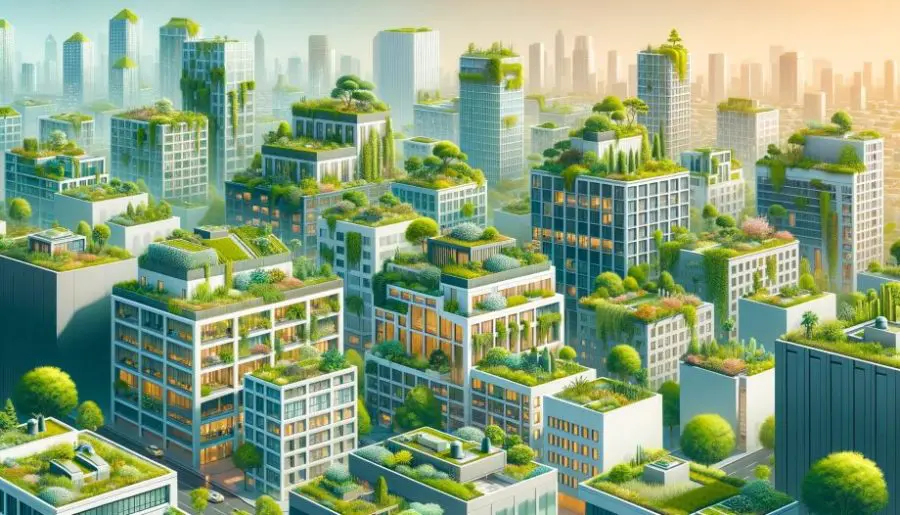
Extensive Green Roofs
Extensive green roofs are like the low-key members of the green roof family. These roofs are not about flashy, high-maintenance gardens.
Instead, they’re covered with hardy, low-growing vegetation like moss, herbs, and grasses. They’re designed to be self-sustaining with minimal fuss.
- Features What makes extensive green roofs stand out is their lightweight nature and shallow soil depth, usually between 60-200mm.
- This makes them ideal for a variety of buildings without needing major structural reinforcements.
- Vegetation and Maintenance Typical plants for extensive roofs include sedums, mosses, and drought-tolerant grasses.
- These plants are chosen for their resilience and low maintenance needs.
- They don’t require frequent watering or intensive care, making them a practical choice for busy city dwellers.
Semi-Intensive Green Roofs
Semi-intensive green roofs are the middle ground. They blend the ease of extensive roofs with the diversity of intensive ones.
These roofs can support a wider range of plants, including small shrubs and perennials.
- Description Semi-intensive green roofs are the middle ground.
- They blend the ease of extensive roofs with the diversity of intensive ones.
- These roofs can support a wider range of plants, including small shrubs and perennials.
- Features With a moderate substrate depth of 120-250mm, these roofs are a bit heavier than extensive ones but offer more options for planting.
- They strike a balance between ecological benefits and aesthetic appeal.
- Plant Types and Maintenance You’ll find a mix of sedums, ornamental grasses, and even small flowering plants on semi-intensive roofs.
- These plants require a bit more care than those on extensive roofs, like occasional watering and maintenance, but they’re still relatively low-maintenance.
Intensive Green Roofs
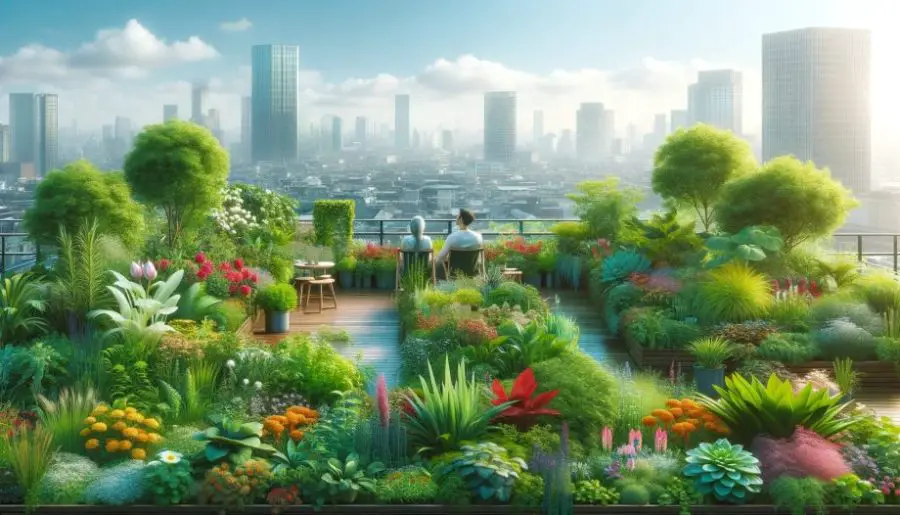
Intensive green roofs are the show-stoppers. They’re essentially rooftop gardens or parks, complete with walkways, seating areas, and a wide variety of plants, including large shrubs and trees.
- Description: These are akin to rooftop gardens or parks, with deeper soils for large plants and trees.
- Features Because of their elaborate nature, intensive green roofs need strong structural support.
- They have a deep substrate layer, usually between 150-400mm, to accommodate larger plants and even trees.
- Plant Diversity and Maintenance These roofs can host a diverse range of plants, from flowering perennials to small trees.
- They require regular maintenance, similar to a traditional garden, including watering, pruning, and soil care.
Innovative Types
- Solar Garden Roofs Solar garden roofs are a cutting-edge combination of green roofing and solar energy technology.
- They feature solar panels integrated into the green roof, providing both renewable energy and the ecological benefits of a green roof.
- Blue-Green Roofs Blue-green roofs take water management to the next level.
- They combine the features of green roofs with systems for stormwater retention and reuse.
- This design is particularly beneficial in urban areas prone to heavy rainfall, reducing the strain on drainage systems.
Each type of green roof offers unique benefits and suits different needs.
Whether it’s the simplicity of extensive roofs, the balanced approach of semi-intensive ones, the lushness of intensive roofs, or the innovative aspects of solar and blue-green roofs, there’s an option for every urban space.
Green Roof Comparison Table
This table outlines key aspects such as soil depth, weight, types of plants, maintenance requirements, installation cost, and primary use for each type of green roof: extensive, semi-intensive, and intensive.
| Type of Green Roof | Soil Depth | Weight | Plant Types | Maintenance | Installation Cost | Primary Use |
|---|---|---|---|---|---|---|
| Extensive | 2-6 inches | Light | Sedums, mosses, grasses | Low | Lower | Environmental benefits |
| Semi-Intensive | 5-7 inches | Moderate | Sedums, ornamental grasses, small shrubs | Moderate | Medium | Balance of aesthetics and ecology |
| Intensive | 8-24 inches | Heavy | Large shrubs, trees, perennials | High | Higher | Recreational space, biodiversity |
This table provides a concise comparison to help understand the differences between the three main types of green roofs.
3. Planning and Implementation
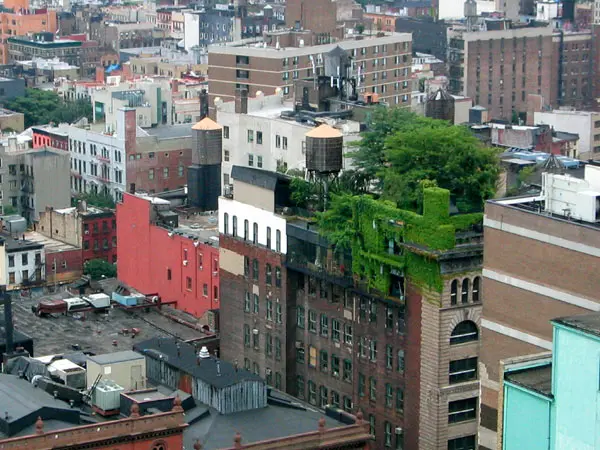
Considerations for Choosing a Green Roof Type
- Building Structure: The existing structure of a building is crucial. Can it support the weight of a green roof, especially intensive types with deeper soils and heavier vegetation? Structural analysis is essential to determine the type of green roof suitable for the building.
- Climate: The local climate influences the choice of plants and the design of the green roof. For instance, areas with low rainfall might be better suited for drought-resistant plants often used in extensive green roofs.
- Intended Use: What is the purpose of the green roof? Is it for aesthetic enhancement, environmental benefits, or recreational space? Intensive green roofs are great for recreational spaces, while extensive roofs are ideal for environmental benefits with minimal maintenance.
Overview of the Installation Process
- Initial Assessment: This includes checking the roof’s load-bearing capacity and ensuring proper waterproofing. It’s crucial to address any repairs before installation.
- Design Phase: This involves selecting the type of green roof and planning its layout, including the choice of vegetation, drainage systems, and other features like walkways (for intensive roofs).
- Installation Steps:
- Waterproofing and Root Barrier Layer: A waterproof membrane is essential to protect the building. A root barrier prevents roots from damaging the structure.
- Drainage and Insulation Layers: These layers manage water flow and maintain temperature control.
- Growing Medium (Soil) Layer: The depth varies based on the green roof type – shallow for extensive and deeper for intensive roofs.
- Plant Installation: For extensive roofs, pre-grown vegetation mats are often used, while intensive roofs might require planting individual shrubs and plants.
- Irrigation System (if needed): Especially important for semi-intensive and intensive roofs.
- Maintenance Planning: Developing a maintenance plan is crucial, especially for intensive green roofs that require more care. Even extensive roofs need occasional checks for plant health and drainage efficiency.
Each step in the planning and implementation of a green roof is vital to its success.
While extensive roofs might be easier to install, intensive roofs offer more usage but come with higher installation and maintenance requirements.
Proper planning ensures the green roof is not only aesthetically pleasing but also functional and sustainable.
4. Maintenance and Upkeep
Maintaining a green roof is key to its longevity and effectiveness. It’s not just about keeping the plants alive; it’s about ensuring the roof continues to provide environmental benefits and remains safe and functional.
The maintenance required varies depending on the type of green roof, but each comes with its own set of challenges and solutions.
General Maintenance Guidelines
- Extensive Green Roofs: These are the low-maintenance champs.
- Routine Tasks: Inspect for weeds, ensure proper drainage, and check the health of plants.
- Seasonal Checks: Twice a year, clear debris and dead vegetation, and inspect the waterproof membrane.
- Irrigation: Typically, extensive roofs need minimal watering, but check during prolonged dry spells.
- Semi-Intensive Green Roofs: A bit more hands-on than extensive roofs.
- Regular Care: Regular weeding, pruning, and checking for pests or diseases.
- Soil and Fertilization: Monitor soil health and add fertilizer as needed, usually once a year.
- Watering: These roofs may require occasional watering, especially in dry conditions.
- Intensive Green Roofs: These require the most upkeep, similar to a traditional garden.
- Frequent Maintenance: Regular watering, weeding, pruning, and pest control.
- Structural Checks: Regularly check the integrity of the roof, especially weight-bearing areas.
- Seasonal Tasks: Seasonal planting, soil turnover, and mulching.
Challenges and Solutions in Green Roof Maintenance
- Water Management: Overwatering can lead to leaks and structural damage, while under-watering can kill plants. Solution: Install a proper drainage system and consider smart irrigation systems for intensive roofs.
- Plant Health: Pests, diseases, and poor plant growth can occur. Solution: Regularly inspect plants and use eco-friendly pest control methods. Choose native or adaptive plant species for better resilience.
- Access and Safety: Especially for intensive green roofs, safe access for maintenance is crucial. Solution: Ensure that there is safe and easy access for regular maintenance.
- Long-Term Care: Over time, soil can become compacted, and nutrients may be depleted. Solution: Regularly aerate the soil and replenish nutrients as needed.
Effective maintenance ensures that green roofs continue to provide environmental benefits like temperature regulation, biodiversity, and stormwater management.
It also ensures the safety and longevity of the roof structure itself.
Regular care, although varying in intensity, is a small price to pay for the multitude of benefits these living roofs offer.
5. Benefits of Green Roofs
Green roofs are not just a visual treat; they are powerhouses of environmental, economic, and social benefits.
Their impact is far-reaching, from transforming urban landscapes to enhancing the well-being of city dwellers.
Environmental Impact
- Reducing Urban Heat Islands: Green roofs play a significant role in cooling cities. They absorb sunlight and provide shade, which helps in lowering surface and air temperatures. This is particularly important in urban areas where concrete and asphalt absorb heat, leading to higher temperatures.
- Improving Air Quality: Plants on green roofs filter pollutants and particulate matter from the air, contributing to cleaner and healthier urban environments. They also produce oxygen, which further improves air quality.
Economic Benefits
- Energy Efficiency: By providing natural insulation, green roofs help reduce the need for heating in winter and air conditioning in summer. This leads to significant energy savings and reduced utility bills for building owners.
- Increasing Property Value: Buildings with green roofs are often more desirable, leading to higher property values. They also have the potential to extend the lifespan of the roof, resulting in long-term savings on roof repair and replacement costs.
Social and Health Benefits
- Enhancing Aesthetic Appeal: Green roofs can transform bland urban landscapes into vibrant, green spaces. They offer a visual break from the monotony of concrete, enhancing the overall aesthetic appeal of buildings.
- Promoting Biodiversity: By creating habitats for various species of birds, insects, and plants, green roofs contribute to increased biodiversity in urban areas. This is crucial, especially in cities where natural habitats are limited.
Green roofs are a holistic solution to many urban challenges. They offer a unique combination of benefits, contributing to more sustainable, livable, and resilient cities.
Their adoption can be a significant step towards addressing environmental concerns while providing economic and social advantages.
6. Case Studies and Examples
Green roofs have been implemented worldwide, showcasing a variety of designs and purposes. Each project highlights specific benefits and challenges, providing valuable insights into the practical application of green roofing.
Museé du Quai Branlys Vertical Garden – Paris, France
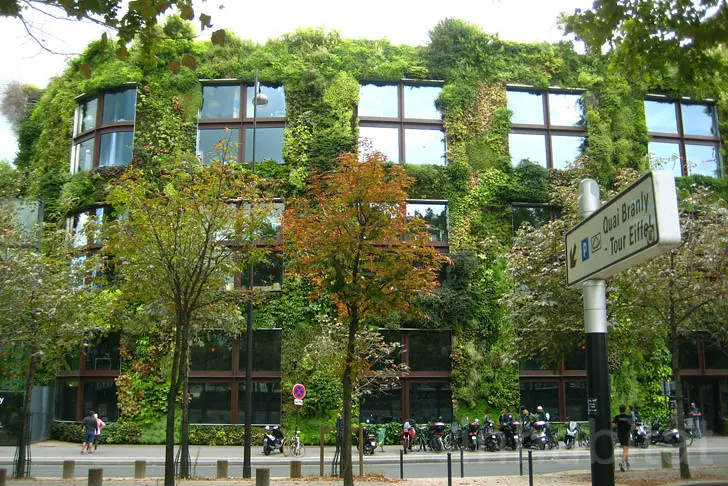
Designed by Dr. Patrick Blanc, this vertical garden is a stunning example of urban greenery in Paris. Its location near the River Seine creates a favorable microclimate for a variety of plants, making it a highly photographed green wall worldwide. Read more
California Academy of Sciences Living Roof – San Francisco, USA
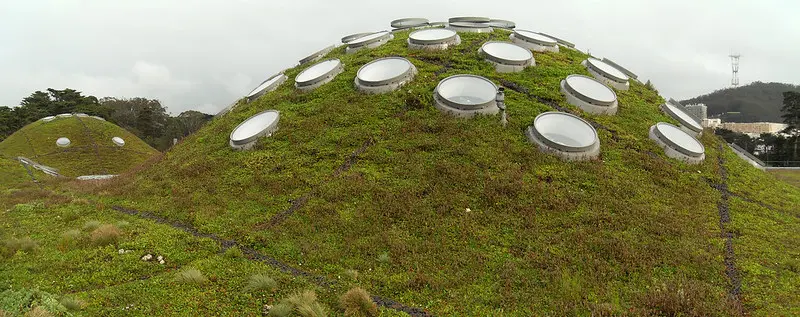
Known for its unique design, the California Academy of Sciences features a 2.5-acre green roof.
It embodies the seven major hills of San Francisco, hosting native Californian plants that attract local wildlife.
The roof contributes significantly to energy efficiency and provides natural lighting and air circulation for the building. Read more
Vancouver Convention Centre – Vancouver, Canada
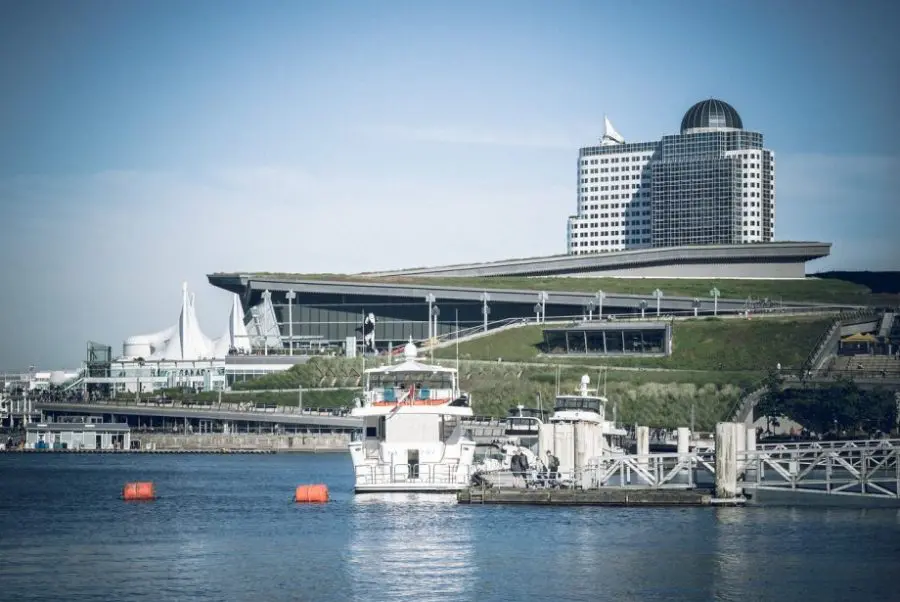
This six-acre living roof is the largest in Canada and features over 400,000 indigenous plants.
It serves as an excellent insulator and includes beehives for pollination and honey production.
The roof’s design highlights both ecological function and aesthetic value. Read more
The Nanyang Technological University – Singapore
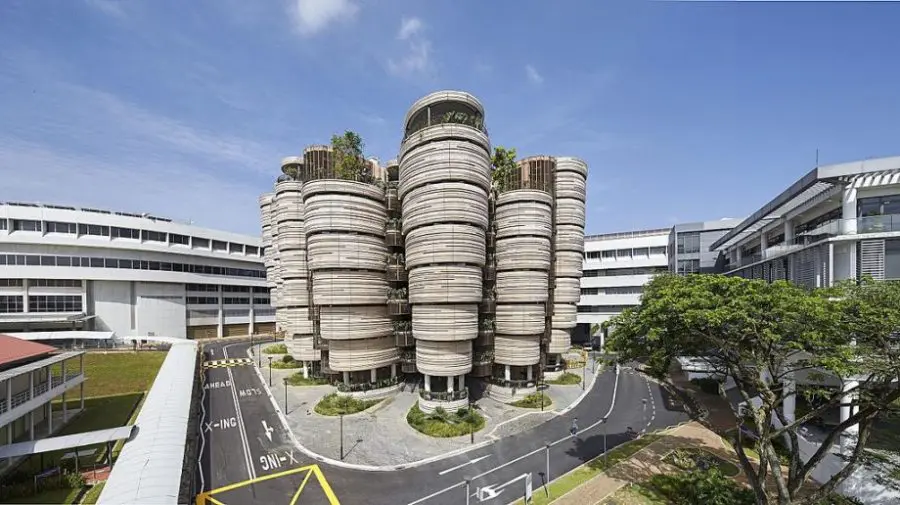
Featuring a green roof that slopes at a near 45-degree angle, this university’s School of Art Design and Media merges architectural beauty with environmental responsibility.
The roof helps maintain ambient temperature and includes a reflective pond for cooling. Read more
The Global Change Institute at the University of Queensland – Brisbane, Australia
This building stands out for its comprehensive approach to sustainability.
It’s a zero-carbon, 6-star Green Star rated structure, with a green roof that enhances its energy efficiency and sustainability credentials. Read more
ACROS Fukuoka Prefectural International Hall – Fukuoka City, Japan
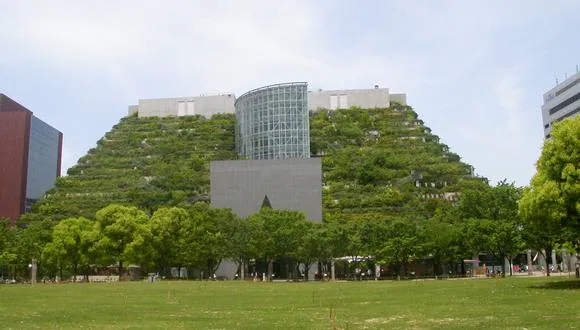
A prime example of merging green space with urban development, this building features 15 stepped terraces of greenery, creating a public park on its roof.
It demonstrates how green roofs can balance urban development needs with public green space requirements. Read more
Chicago City Hall Green Roof – Chicago, USA
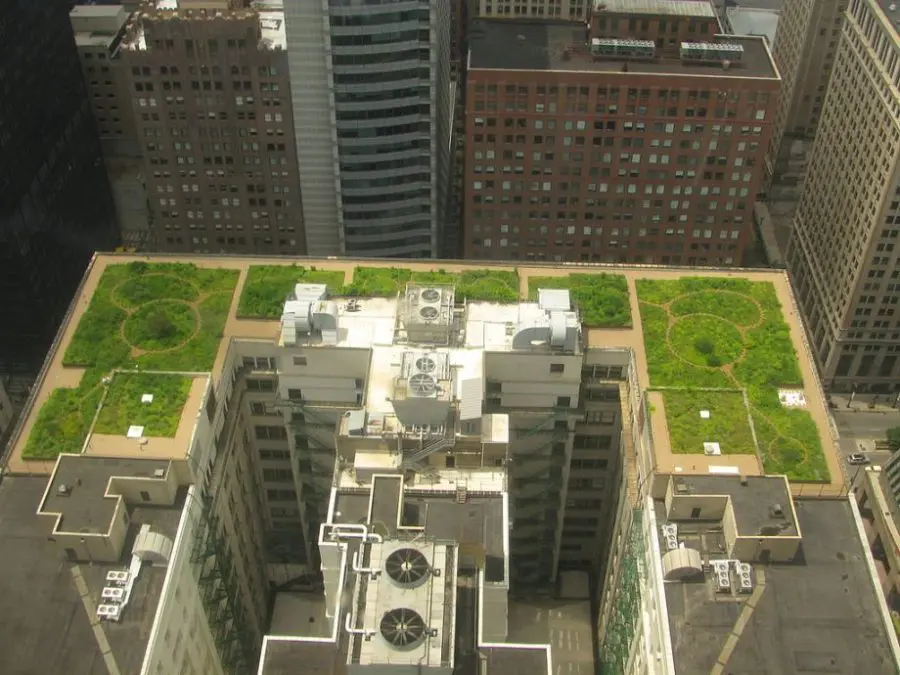
A pioneer in green roofing, the City Hall garden is a diverse ecosystem with over 150 plant species. It was established to test green roof benefits, improving air quality and reducing the urban heat island effect significantly. Read more
The Solaire – New York, USA
As the first residential high-rise in the US to incorporate a green roof, The Solaire combines extensive and intensive green roof systems.
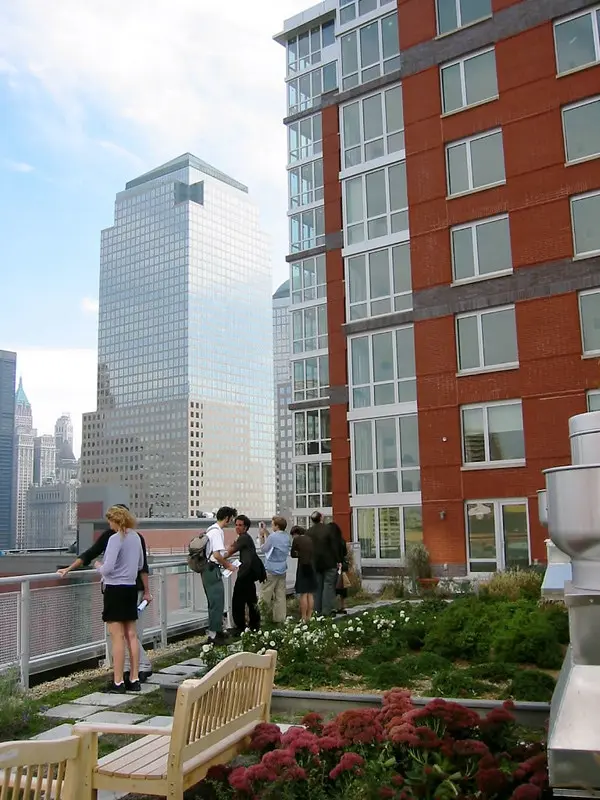
It offers residents a sustainable landscape with groundcovers, sedums, and deeper planting beds for a variety of vegetation. Read more
These case studies from around the world, including information from American Forests and Roofed Right America, demonstrate the versatility and effectiveness of green roofs.
They highlight how green roofs can be tailored to suit various climates, building types, and purposes, from enhancing biodiversity to improving building energy efficiency and creating valuable urban green spaces.
Types of Green Roofs FAQs
Green roofs are fascinating, and it’s natural to have questions about them.
Here are some answers to common queries about green roofs, covering everything from their types and maintenance to their benefits and limitations.
Q: What are the different types of green roofs?
A: Green roofs come mainly in three types: extensive, semi-intensive, and intensive.
- Extensive green roofs are low-maintenance with shallow soil, ideal for small plants like mosses and sedums.
- Semi-intensive green roofs offer a middle ground with moderate maintenance and deeper soil for a wider variety of plants.
- Intensive green roofs are like rooftop gardens, requiring more maintenance and capable of supporting large plants and even trees.
Q: What are the different types of Sedum roofs?
A: Sedum roofs are a subset of extensive green roofs, primarily using sedum plants.
These are low-growing, drought-tolerant plants that come in various species, suitable for different climates and roof conditions.
Q: What is the difference between an intensive green roof and an extensive green roof?
A: Intensive green roofs are thick and heavy, and support a wide variety of plants, including large shrubs and trees.
They require significant maintenance, similar to a regular garden.
Extensive green roofs, on the other hand, are lightweight, with a shallow growing medium for small, hardy plants, and require minimal maintenance.
Q: What are two drawbacks of green roofs?
A: Two main drawbacks of green roofs are the higher initial installation costs and the need for a strong structural support system, especially for intensive green roofs. They can also require more maintenance than traditional roofs.
Q: Can you walk on an extensive green roof?
A: Generally, it’s not recommended to walk on an extensive green roof, as they are designed for low maintenance and not for foot traffic.
The plants and growing medium are typically not robust enough to handle regular walking.
Q: What is the biggest limitation to having a green roof?
A: The biggest limitation is often the structural capacity of the building.
Especially for intensive green roofs, the weight of the soil, plants, and retained water can be significant, and not all buildings can support this additional load without reinforcement.
Q: How long do extensive green roofs last?
A: With proper maintenance, extensive green roofs can last up to 50 years or more.
The longevity depends on the quality of installation, climate conditions, and regular maintenance.
Q: Do green roofs increase property value?
A: Yes, green roofs can increase property value. They offer aesthetic appeal, energy efficiency, and environmental benefits, which can make properties more attractive to buyers and tenants.
Q: Why are green roofs so expensive?
A: The cost comes from the need for additional structural support, waterproofing, drainage systems, high-quality soil, and plants.
Intensive green roofs are particularly expensive due to their complexity and maintenance requirements.
Q: How deep does a green roof need to be?
A: The depth varies by type. Extensive green roofs can be as shallow as 2-6 inches, while intensive green roofs may need a depth of 8 inches to several feet to accommodate larger plants and trees.
Q: Do green roofs require a lot of maintenance?
A: It depends on the type. Extensive green roofs require minimal maintenance, while intensive green roofs need regular care similar to a traditional garden.
Q: Can I turn my flat roof into a green roof?
A: Yes, flat roofs are often suitable for green roofs.
However, you should first have a structural assessment to ensure the roof can bear the additional weight, and proper waterproofing and drainage must be in place.
Q: What is a hybrid green roof?
A: A hybrid green roof combines elements of both extensive and intensive green roofs.
It typically has areas with shallow soil for low-maintenance plants and deeper sections for more diverse vegetation.
Q: What goes under a sedum roof?
A: Under a sedum roof, you will typically find a waterproof membrane, a root barrier, a drainage layer, and a lightweight growing medium specifically designed for sedum plants.
Q: Is a sedum roof the same as a green roof?
A: A sedum roof is a type of green roof, specifically an extensive green roof.
It primarily uses sedum plants, known for their low maintenance and drought tolerance.
Q: What is the life expectancy of a sedum roof?
A: Sedum roofs can last up to 40 years or more with proper installation and maintenance. Their longevity is due in part to the hardy nature of sedum plants.
7. Different Types of Green Roofs Conclusion
The Vital Role of Green Roofs in Urban Landscapes
Green roofs have emerged as essential elements in reshaping urban environments.
They are not just visually pleasing; they address critical environmental issues in dense urban areas.
By bringing vegetation to city skylines, green roofs help mitigate the urban heat island effect, improve air quality, and enhance biodiversity.
Environmental Benefits and Urban Sustainability
The environmental impact of green roofs is profound. They act as natural insulators, reducing the need for artificial heating and cooling, thus conserving energy.
Their ability to absorb and manage stormwater diminishes the stress on urban drainage systems.
Plus, they provide habitats for wildlife, contributing to ecological diversity even in urban settings.
Encouraging Green Roof Adoption
The adoption of green roofs is a step towards sustainable urban development.
Encouraging their integration into both new and existing structures can bring about significant environmental, economic, and social benefits.
Green roofs are not just the responsibility of urban planners and architects; they require the support and understanding of the entire community to realize their full potential.
Supporting Green Roof Initiatives
Supporting green roof initiatives can take many forms, from policy-making and providing financial incentives to raising public awareness about their benefits.
As cities continue to grow, the incorporation of green roofs can play a pivotal role in ensuring that this growth is sustainable and environmentally responsible.
Green roofs stand as a testament to the possibility of a greener, more sustainable future in urban areas.
Their widespread adoption and support can lead to healthier, more resilient cities, benefiting both the environment and the people who live in them.
Resource Section
For those interested in learning more about green roofs, diving deeper into their benefits, and understanding their implementation, there are several valuable resources available.
Here’s a list of articles and websites that provide in-depth information, case studies, and guidance on green roofs.
- American Forests: Offers an insightful article titled Impressive Green Roofs around the World, which showcases various international green roof projects and their unique features.
- Roofed Right America: This resource includes a compilation of 8 Unbelievable Green Roof Examples & Designs in the USA, providing a closer look at innovative green roof projects in urban settings.
- Green Roofs for Healthy Cities: A leading industry association that provides extensive resources on green roof benefits, design, and policy. It’s a great starting point for understanding the impact and implementation of green roofs.
- The Living Architecture Monitor: Offers articles, research, and case studies on green roofs, walls, and other forms of living architecture.
These resources are excellent starting points for anyone looking to explore the world of green roofs further, whether for professional, academic, or personal interest.
They offer a wealth of information that can help inform decisions about green roof design, installation, and maintenance.

